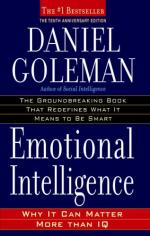
|
| Name: _________________________ | Period: ___________________ |
This test consists of 5 multiple choice questions, 5 short answer questions, and 10 short essay questions.
Multiple Choice Questions
1. The neocortex is the "seat of” what, according to the author in Part One: Chapter 1, “What Are Emotions For?”
(a) Empathy.
(b) Thought.
(c) Anger.
(d) Language.
2. What is medically recognized as a mental and emotional condition in which a person experiences intense feelings of depression, discontent and indifference to the world around them?
(a) Dysphoria.
(b) Bipolar disorder
(c) Depression.
(d) Narcissistic personality disorder.
3. Alexithymia is a term coined by what psychotherapist in 1972?
(a) Peter Sifneos.
(b) Thomas Borkovec.
(c) Lewis Terman.
(d) Bruce McEven.
4. According to the author in Part Two: Chapter 6, “The Master Aptitude,” the superior achievement of Asian-Americans comes more from what than from IQ?
(a) Politics and religion.
(b) Effort and determination.
(c) Genetics and environment.
(d) Culture and music.
5. Dolf Zillmann gives two methods for diffusing anger. What is the second?
(a) Remove yourself from the setting that triggers the anger.
(b) Challenge the angry thoughts before taking action.
(c) Find someone to council you about the anger.
(d) Release the anger in a constructive manner.
Short Answer Questions
1. Emotions, like instincts, have helped humans survive by doing what, according to the author in Part One: Chapter 1, “What Are Emotions For?”
2. The left and right pre-frontal lobes of the brain’s cortex balance the emotional responses of what?
3. Psychologists Lizabeth Roemer and Thomas Borkovec work at what university?
4. Researcher Paul Ekman names three kinds of display rules in Part Two: Chapter 8, “The Social Arts.” What is the third?
5. Daniel Goleman currently co-directs the Consortium for Research on Emotional Intelligence in Organizations at what university?
Short Essay Questions
1. Psychologists Lizabeth Roemer and Thomas Borkovecresearched worry and recommend two steps to reverse the worry habit. How are these described in Part Two: Chapter 5, “Passion's Slaves”?
2. Where in the brain is the limbic system located? What purpose does this section of the brain serve?
3. How is emotional hijacking described in Part One: Chapter 2, “Anatomy of an Emotional Hijacking”?
4. What did Daniel Stern term the process of reinforcing empathy in children? How is this defined in Part Two: Chapter 7, “The Roots of Empathy”?
5. What term does Dr. Antonio Damasio give for “gut feelings”? What is their importance?
6. What are positive uses of emotion, according to the author in Part Two: Chapter 6, “The Master Aptitude”?
7. What did Dolf Zillmann discover about anger, according to the author in Part Two: Chapter 5, “Passion's Slaves”?
8. Psychologist John Mayer, of the University of New Hampshire, names three styles of handling one's emotions. How are these described in Part Two: Chapter 4, “Know Thyself”?
9. What discovery did Joseph LeDoux make in the study of emotional hijacking?
10. What four interpersonal intelligence components make up charisma, according to the author in Part Two: Chapter 8, “The Social Arts”? Who defined these components?
|
This section contains 898 words (approx. 3 pages at 300 words per page) |

|




